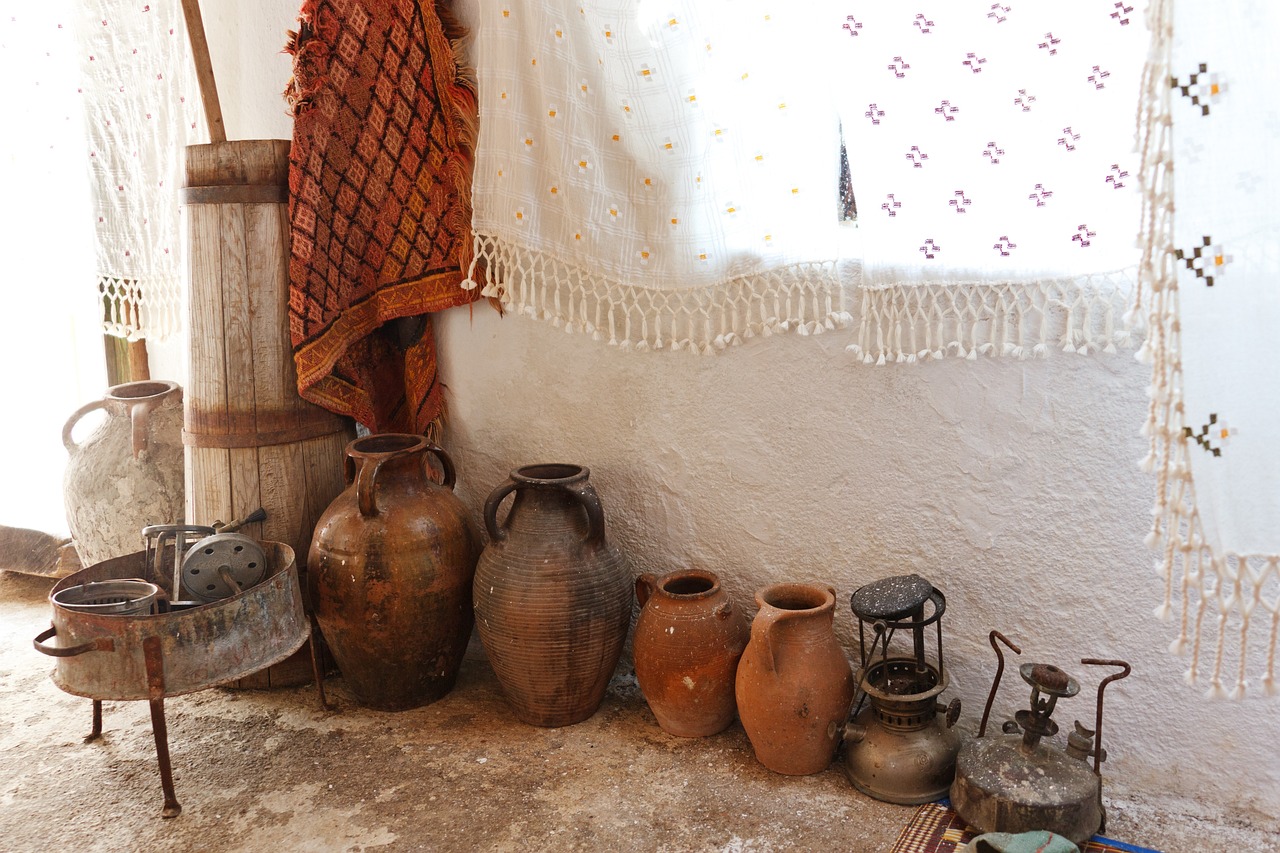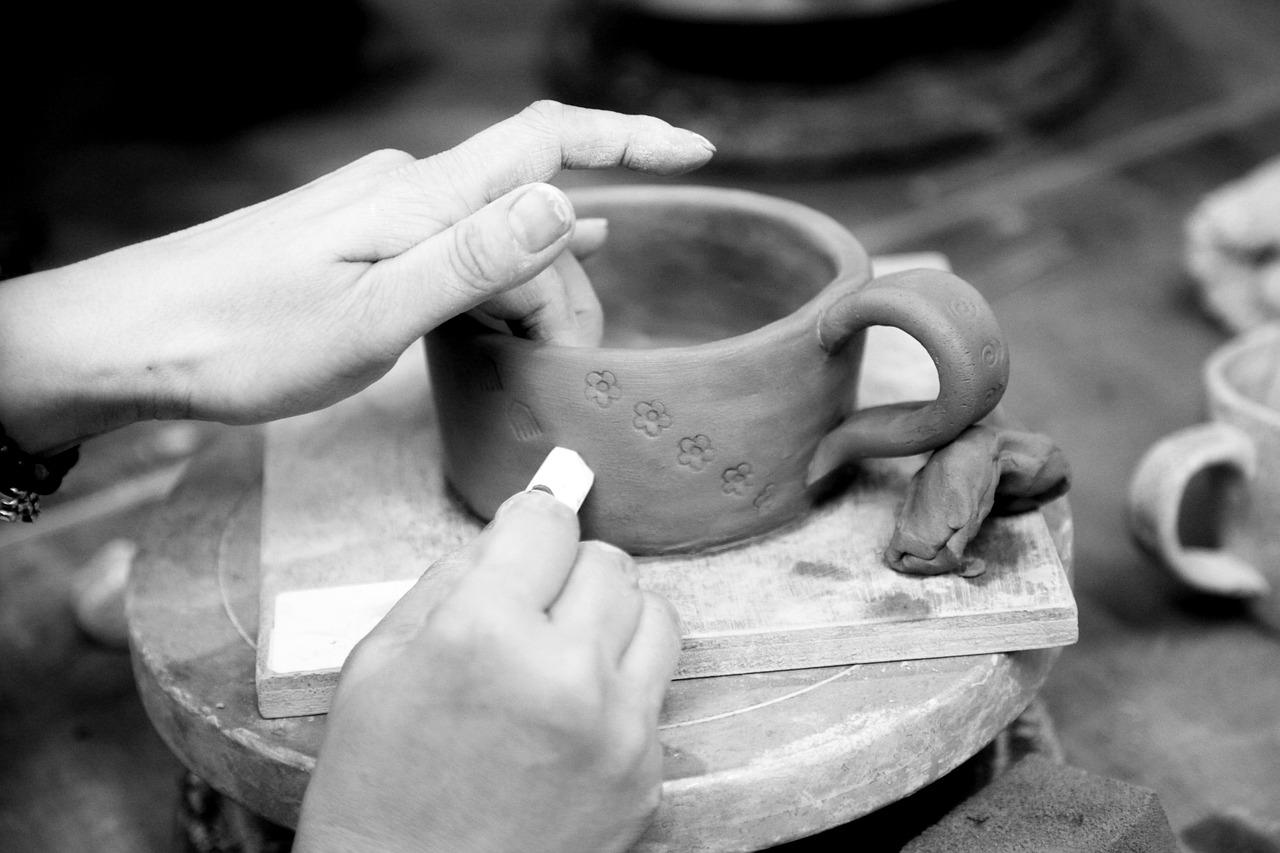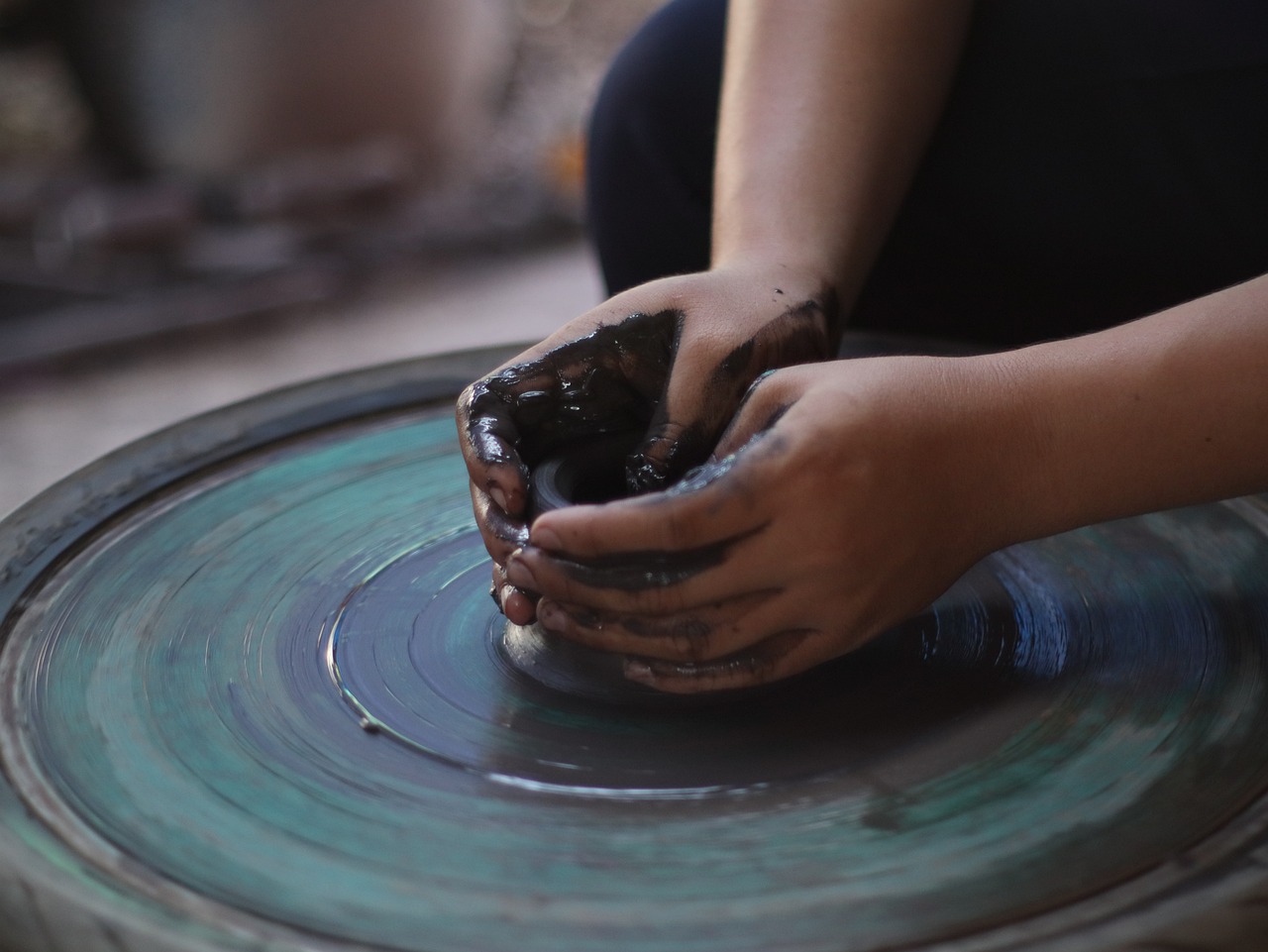How to Sell Your Pottery Online: A Beginner's Guide
Welcome to the exciting world of online pottery sales! If you’re an artist looking to share your unique creations with the world, you’ve come to the right place. In today's digital age, selling your pottery online is not just a possibility; it’s a fantastic opportunity to reach a global audience. Imagine your beautifully crafted mugs, vases, and bowls being appreciated by customers from all corners of the globe! This guide aims to provide you with essential tips and strategies that will help you navigate the online marketplace and successfully sell your pottery. From choosing the right platform to effective marketing techniques, we’ll cover everything you need to know to turn your passion into profit.
When it comes to selling pottery online, selecting the ideal platform is crucial. Think of it as choosing the right canvas for your artwork; the right platform can make a world of difference. There are several options available, each with its own set of advantages:
- Etsy: A well-known marketplace for handmade goods, perfect for reaching a niche audience.
- Shopify: Ideal for those wanting to create a personalized online store with more control over branding.
- Personal Website: Gives you complete ownership and flexibility, but requires more effort in driving traffic.
Consider your business model and target audience carefully. Each platform has its unique features, fees, and audience demographics, so take the time to research and choose wisely.
Once you've chosen a platform, the next step is creating high-quality listings that can significantly impact your sales. Think of your product listings as the first impression you make on potential customers; you want it to be captivating! Start with compelling descriptions that tell the story behind each piece. What inspired you? What materials did you use? This personal touch can create an emotional connection with buyers.
Good photography is vital for online sales. Your pottery deserves to shine in the spotlight! Here are some techniques to enhance your product photos:
Proper lighting can make or break your product photos. Natural light is often the best choice, as it brings out the true colors and textures of your pottery. However, if you're shooting indoors, consider using softbox lights or LED panels to avoid harsh shadows.
The background of your photos can influence buyer perception. Opt for simple, neutral backgrounds that complement your pottery without stealing the show. A plain white or soft pastel backdrop can help your creations pop!
Crafting engaging product descriptions helps convey your pottery's story. Use descriptive language to highlight unique features, dimensions, and care instructions. Don’t forget to include keywords that potential buyers might search for. This will not only inform your customers but also improve your SEO!
Now that your listings are live, effective marketing is key to driving traffic. Think of marketing as the megaphone that amplifies your voice in the crowded online marketplace. Here are some strategies to consider:
Social media platforms are powerful tools for reaching potential customers. Create engaging content that showcases your pottery, such as behind-the-scenes videos of your creative process or customer testimonials. Platforms like Instagram and Pinterest are particularly visual and can help build a following that supports your pottery business.
An email list can help maintain customer relationships. Consider offering a discount for first-time subscribers or exclusive access to new collections. Regular newsletters can keep your audience engaged and informed about upcoming sales or events.
Shipping can be a complex aspect of selling online. Think of it as the final touch that ensures your pottery arrives safely and in perfect condition. Learn best practices for packaging, shipping options, and calculating costs to ensure a smooth delivery process.
Proper packaging is essential to prevent damage during transit. Use bubble wrap, packing peanuts, or crumpled paper to cushion your pottery. A well-packaged item not only protects your work but also creates a positive unboxing experience for your customers.
Understanding shipping options can save you time and money. Research different carriers and services, comparing their rates and delivery times. Consider offering multiple shipping options to cater to your customers' preferences.
Excellent customer service can lead to repeat business. Think of your customers as partners in your pottery journey; their satisfaction is key to your success. Learn how to handle inquiries, manage feedback, and create a positive shopping experience.
Timely responses to customer inquiries can enhance satisfaction. Make it a habit to check your messages regularly and respond promptly. This shows that you value their interest and builds trust.
Managing returns and feedback is crucial for maintaining a good reputation. Be transparent about your return policy and handle any issues with professionalism. Constructive feedback can be a valuable tool for improving your business.
Q: How do I price my pottery?
A: Consider the cost of materials, time spent creating each piece, and the prices of similar items in your chosen marketplace.
Q: Do I need a business license to sell pottery online?
A: This depends on your location. Check local regulations to ensure compliance.
Q: How can I promote my pottery effectively?
A: Utilize social media, collaborate with other artists, and consider running online ads to reach a broader audience.

Choosing the Right Platform
When it comes to selling your pottery online, is like picking the perfect canvas for your masterpiece. Each platform offers unique features and benefits that cater to different needs and styles. So, how do you determine which one is the best fit for your pottery business? Let's dive into the most popular options available and explore what they can offer you.
One of the most well-known platforms for handmade goods is Etsy. This marketplace is a haven for artisans and crafters alike, allowing you to reach an audience that appreciates unique, handmade items. With Etsy, you can set up your shop quickly, and the platform provides built-in traffic from customers actively searching for pottery. However, keep in mind that there are fees for listing and selling items, which can add up over time.
If you prefer more control over your branding and customer experience, Shopify might be the way to go. This platform allows you to create a personalized online store without needing extensive technical skills. You can customize your site, manage inventory, and even integrate various payment options. Although Shopify comes with a monthly fee, the potential for higher profit margins can make it worthwhile, especially if you plan to scale your business.
For those who want to maintain full control and create a unique online presence, a personal website is a fantastic option. Building your website gives you the freedom to design it exactly how you envision, and you can also implement SEO strategies to attract organic traffic. Platforms like WordPress or Squarespace make it relatively easy to create a stunning site, but you’ll need to invest time and effort into marketing to drive visitors to your online store.
Here’s a quick comparison of these platforms:
| Platform | Best For | Fees | Customization |
|---|---|---|---|
| Etsy | Handmade goods market | Listing and transaction fees | Limited |
| Shopify | Custom branding | Monthly subscription | Highly customizable |
| Personal Website | Full control | Hosting and domain fees | Fully customizable |
Ultimately, the choice of platform will depend on your specific goals, the amount of time you are willing to invest, and your budget. Consider your target audience and how they prefer to shop. Do they frequent marketplaces like Etsy, or are they more likely to browse individual websites? By answering these questions, you’ll be better equipped to choose the right platform that aligns with your pottery business vision.

Creating High-Quality Listings
When it comes to selling pottery online, the first impression is everything. Your product listings are like your storefront; they need to be inviting, informative, and visually appealing. A well-crafted listing can be the difference between a potential buyer clicking 'add to cart' or scrolling past your item. So, how do you create listings that not only attract attention but also convert views into sales? Let's dive into the essentials of crafting high-quality listings that showcase your pottery in the best light.
First and foremost, high-quality photographs are crucial. Think of your pottery as a piece of art; it deserves to be displayed beautifully. Use natural light whenever possible, as it brings out the true colors and textures of your pieces. If you're shooting indoors, position your pottery near a window or in a well-lit area. Consider using a lightbox for a more controlled environment. Remember, the goal is to capture the essence of your work. A stunning image can evoke emotions and spark interest, making potential buyers feel connected to your creation.
Now, let’s break down some practical tips to elevate your photography:
- Lighting Techniques: Proper lighting can make or break your product photos. Natural light is ideal, but if you're shooting at night or in low-light conditions, consider investing in softbox lights or ring lights. These can help to eliminate harsh shadows and highlight the intricate details of your pottery.
- Background Choices: The background of your photos can influence buyer perception. Opt for simple, neutral backgrounds that won’t distract from your pottery. A plain white or light-colored surface can often work wonders, making your pieces pop.
- Angles and Perspectives: Experiment with different angles to showcase your pottery. A straight-on shot can work well for bowls and plates, while a slight tilt might be better for vases or sculptural pieces. Don’t be afraid to get creative!
Once your photos are ready, it’s time to tackle the product descriptions. A compelling description does more than just list the features; it tells a story. Describe the inspiration behind your piece, the materials used, and any unique techniques you employed. This not only adds value but also helps potential customers connect emotionally with your work. Think of it as sharing a piece of your journey as an artist.
When writing your descriptions, aim to include essential details while keeping it engaging. Here are some key elements to consider:
- Dimensions and Weight: Buyers want to know what they’re getting, so be sure to include accurate measurements and weight.
- Materials: Specify the materials used in your pottery, especially if they are unique or sustainable.
- Care Instructions: Provide clear care instructions to help your customers maintain their purchase, which can also reduce the likelihood of returns.
In addition to these elements, infuse your personality into the descriptions. Use a conversational tone that reflects your style as an artist. This approach not only makes your listings more relatable but also builds a connection with your audience. Remember, people love to buy from those they feel they know and trust.
Finally, don’t underestimate the power of SEO (Search Engine Optimization). Incorporate relevant keywords into your titles and descriptions to increase visibility on search engines. Think about what potential buyers might search for when looking for pottery like yours. Use these keywords naturally within your content to improve your chances of being found online.
In summary, creating high-quality listings involves a combination of stunning photography, engaging descriptions, and smart SEO practices. By investing time and effort into this aspect of your online business, you can significantly enhance your chances of attracting buyers and making sales. Remember, your pottery is a reflection of your creativity and passion—let that shine through in every listing!
1. How important are photos for selling pottery online?
Absolutely crucial! Photos are the first thing potential buyers see, and high-quality images can significantly increase your chances of making a sale.
2. What should I include in my product description?
Include dimensions, materials, care instructions, and a story behind the piece to connect with your audience.
3. How can I improve my SEO for pottery listings?
Use relevant keywords in your titles and descriptions, and consider including tags that describe your pottery style and materials.

Photography Tips
When it comes to selling your pottery online, the importance of high-quality photography cannot be overstated. Think of your product photos as the first impression you make on potential buyers. Just like a book cover can entice you to read a story, a stunning photo can draw customers into the unique world of your pottery. So, how do you achieve that captivating shot? It all begins with understanding the fundamentals of photography.
First and foremost, lighting is your best friend. Natural light is often the most flattering for pottery, as it brings out the true colors and textures without the harsh shadows that artificial lighting can create. Try to shoot your pottery during the day, preferably near a window where soft, diffused light can pour in. If you must rely on artificial lighting, consider using softbox lights or LED panels that mimic daylight. The goal is to illuminate your pieces in a way that highlights their beauty and intricacies.
Next, let’s talk about angles. The angle from which you shoot your pottery can dramatically change how it’s perceived. Experiment with various angles to find the one that best showcases your work. A straight-on shot might work well for bowls, while a slight tilt can give a dynamic feel to vases. Don’t hesitate to take multiple shots from different perspectives; you can always choose the best one later. Remember, a well-composed photo can make your pottery look like a work of art worthy of a gallery wall!
Now, let’s not forget about the backgrounds. A cluttered or distracting background can take away from the beauty of your pottery. Opt for simple, neutral backgrounds that allow your pieces to shine. White or light gray backdrops are popular choices, but you can also use textured materials like wood or fabric to add depth without overwhelming your pottery. The key is to ensure that the background complements rather than competes with your work.
Lastly, consider the importance of post-processing. After you've taken your photos, using editing software to enhance them can make a world of difference. Adjusting brightness, contrast, and saturation can help your pottery look its absolute best. Just be careful not to over-edit; you want your photos to be an honest representation of your work. A well-edited photo can elevate your listings and make them more appealing to potential buyers.
In summary, remember these essential photography tips: utilize natural lighting, experiment with angles, choose complementary backgrounds, and don't shy away from post-processing. By investing time and effort into your photography, you’ll create stunning images that not only attract customers but also tell the story of your craftsmanship.
- What kind of camera do I need for product photography? You don’t need a professional camera; many smartphones have excellent cameras that can do the job just fine. Just ensure you have good lighting!
- How do I avoid reflections in my photos? Use a polarizing filter on your camera lens or adjust your angle to minimize reflections.
- Should I edit my photos? Yes, editing can enhance your photos, but keep it natural. Aim to represent your pottery accurately.

Lighting Techniques
When it comes to selling your pottery online, lighting is everything. Imagine walking into a gallery filled with stunning pieces of art, only to find that the lighting is dim or harsh. It can completely alter your perception of the work, right? The same principle applies to your pottery photos. Proper lighting can enhance the textures, colors, and intricate details of your pieces, making them more appealing to potential buyers. So, how do you achieve that perfect lighting? Let’s explore some essential techniques.
First off, consider using natural light. It’s often the best option for showcasing the true colors and details of your pottery. Set up your shooting area near a window during the day when the light is bright but not too harsh. You want soft, diffused light that doesn’t cast strong shadows. If direct sunlight is too intense, you can use sheer curtains to filter the light, creating a more even illumination that flatters your pieces.
If natural light isn’t an option or if you’re shooting at night, don’t fret! Artificial lighting can work wonders too. Invest in a few softbox lights or LED lights that mimic daylight. Position these lights at 45-degree angles to your pottery to minimize shadows and create a balanced look. You might also want to use a light tent, which can help diffuse the light further and provide a consistent glow around your items.
Another essential aspect to consider is the color temperature of your lights. You want to aim for a color temperature of around 5000K to 6000K, which closely resembles natural daylight. This will ensure that the colors in your photos are true to life, helping potential customers see exactly what they’re getting. If your lighting is too warm or too cool, it can distort the colors of your pottery, leading to disappointment when the item arrives.
Lastly, remember to experiment with different angles and setups. Sometimes, the way light hits your pottery can create beautiful reflections or shadows that add depth to your images. Don’t be afraid to move your pieces around and adjust the lighting until you find that perfect setup. Take multiple shots and compare them; you might be surprised at how a slight change in light direction can completely transform a photo.
To summarize, here are some key points to keep in mind when setting up your lighting for pottery photography:
- Utilize natural light whenever possible for the best results.
- Invest in artificial lighting that mimics daylight if needed.
- Aim for a color temperature of 5000K to 6000K for accurate color representation.
- Experiment with angles and setups to highlight your pottery’s features.
By mastering these lighting techniques, you’ll be well on your way to capturing stunning images that draw in customers and showcase your pottery in the best light possible. Remember, your goal is to create photos that not only represent your work accurately but also evoke an emotional response from potential buyers. Happy shooting!
1. What is the best time of day to photograph pottery?
The best time to photograph pottery is during the day when there’s ample natural light. Early morning or late afternoon provides soft, diffused light that is ideal for showcasing your pieces.
2. Can I use my smartphone for pottery photography?
Absolutely! Many smartphones have excellent cameras capable of taking high-quality images. Just make sure to pay attention to lighting and composition.
3. Do I need to edit my photos after taking them?
Editing can enhance your photos, but it’s essential not to overdo it. Simple adjustments to brightness, contrast, and color balance can make a significant difference.
4. How can I make my pottery stand out in photos?
Use interesting backgrounds and props that complement your pottery without overshadowing it. Good lighting and angles will also help highlight the unique features of your pieces.

Background Choices
When it comes to photographing your pottery, the background you choose plays a crucial role in how your pieces are perceived by potential buyers. A well-selected background can enhance your pottery's visual appeal, making it stand out in a crowded online marketplace. Think of the background as the stage for your work of art; it should complement and elevate your pottery rather than distract from it. Here are some tips to help you make the right choice:
First, consider using a neutral background. White or light gray backgrounds are popular choices because they allow the colors and textures of your pottery to shine without any distractions. This is especially important for intricate designs or vibrant glazes, as a neutral backdrop helps to maintain focus on the piece itself.
Alternatively, you might want to experiment with textured backgrounds. Wood, fabric, or even stone can add depth and character to your photographs. For instance, a rustic wooden table can evoke a warm, homey feel, which might resonate well with buyers looking for handmade items. Just be careful not to choose a background that is too busy or colorful, as it could overshadow your pottery.
Another option is to use themed backgrounds that reflect the style of your pottery. If you create beach-inspired pieces, a sandy or ocean-themed backdrop could enhance the connection between your product and its intended vibe. Similarly, if your pottery has an earthy, natural feel, consider photographing it against a backdrop of greenery or natural stone.
It's also worth experimenting with color contrasts. If you have a piece with soft, muted tones, a bold, contrasting background can make it pop. Conversely, if your pottery is bright and colorful, a softer background can help it stand out without overwhelming the viewer. The key is to find a balance that showcases your pottery in the best light.
Finally, don't forget about the importance of consistency. Whatever background you choose, try to maintain a consistent style across all your product photos. This creates a cohesive look for your online shop, making it easier for customers to recognize your brand and appreciate your artistic vision.
In conclusion, the right background can transform your pottery photos from ordinary to extraordinary. By carefully considering the elements mentioned above, you can create stunning visuals that not only attract potential buyers but also tell the story of your craftsmanship and creativity.
- What type of background is best for pottery photography? Neutral backgrounds like white or light gray are often the best choices, but textured or themed backgrounds can also work well depending on your pottery's style.
- How can I ensure my pottery stands out in photos? Use contrasting colors and consistent styling to make your pottery pop while avoiding busy backgrounds that can distract from your work.
- Should I use natural or artificial light for my photos? Natural light is generally preferred as it highlights the true colors and textures of your pottery, but you can also use artificial lighting to achieve similar effects if managed correctly.

Writing Effective Descriptions
When it comes to selling your pottery online, the way you describe your pieces can make all the difference. A well-crafted description not only informs potential buyers about the product but also tells a story that connects them emotionally to your work. Think of your description as a conversation with your audience—one that invites them into your creative world. So, how do you write descriptions that captivate and convert?
First and foremost, you need to highlight the unique features of your pottery. What sets it apart from the rest? Is it the intricate design, the vibrant colors, or perhaps the special technique you used? Be sure to include details like dimensions, materials, and any special care instructions. For example, instead of simply stating, "This is a vase," you might say, "This hand-thrown ceramic vase, measuring 12 inches tall, features a stunning cobalt blue glaze that shimmers in the light, making it a perfect centerpiece for any table." This not only provides information but also paints a picture in the buyer's mind.
Next, consider the emotional aspect of your pottery. Why did you create this piece? What feelings do you hope it evokes in the person who buys it? Sharing your inspiration can create a bond with potential customers. For instance, you might write, "Inspired by the tranquil waves of the ocean, this bowl captures the essence of calmness and serenity, making it a perfect addition to your home or a thoughtful gift for someone special." This approach allows buyers to see the value beyond just the physical item.
Additionally, don't forget to use descriptive language that appeals to the senses. Words like "smooth," "textured," "vibrant," and "delicate" can evoke a sensory response that pulls the reader in. Instead of saying, "This is a mug," you could say, "Enjoy your morning coffee in this cozy, hand-crafted mug that fits perfectly in your hand, featuring a rustic texture that invites you to linger over each sip." This type of language not only describes the product but also enhances its desirability.
Lastly, consider incorporating keywords relevant to your pottery into the descriptions. This is where SEO comes into play. Think about the words or phrases your target audience might search for. For example, if you specialize in eco-friendly pottery, terms like "sustainable," "handmade," and "natural materials" can help your listings appear in search results. However, be careful not to overstuff your descriptions with keywords; instead, integrate them naturally into your writing.
In summary, effective descriptions are a blend of information, emotion, and sensory appeal. By highlighting unique features, sharing your inspiration, using descriptive language, and incorporating relevant keywords, you can create compelling listings that not only attract attention but also encourage purchases. Remember, your goal is to create a connection with your potential customers, inviting them to see the beauty and value in your pottery.
- What should I include in my pottery descriptions? Focus on unique features, dimensions, materials, care instructions, and your inspiration for the piece.
- How long should my descriptions be? Aim for a balance—enough detail to inform and engage without overwhelming the reader. Typically, 150-300 words is a good range.
- How can I improve my SEO for pottery listings? Use relevant keywords naturally in your descriptions, titles, and tags to help customers find your work through search engines.

Marketing Your Pottery
Once you've set up your online store and your beautiful pottery is ready to be showcased, the next big challenge is to get it in front of the right audience. Think of marketing as the megaphone that amplifies your voice in the crowded marketplace. You want to be heard, and more importantly, you want to attract customers who will appreciate the artistry of your creations. So, how do you do that? Here are some effective strategies to consider.
First off, social media is a game changer in the world of online sales. Platforms like Instagram, Facebook, and Pinterest are visually driven, making them perfect for pottery artists. By sharing stunning images of your work, behind-the-scenes glimpses of your creative process, and engaging stories about your pottery, you can build a loyal following. But remember, it’s not just about posting; it’s about engaging. Respond to comments, ask questions, and create a community around your art. This interaction not only fosters relationships but also encourages word-of-mouth marketing, which is incredibly powerful.
Next, consider the power of email marketing. Building an email list is like creating a direct line of communication with your most interested customers. You can send out newsletters featuring your latest pieces, special promotions, and even pottery tips. To get started, offer something valuable in return for their email addresses, like a discount on their first purchase or exclusive access to new collections. A well-crafted email can remind potential buyers about your pottery and drive them back to your shop.
Additionally, don’t underestimate the potential of collaborations. Partnering with other artists or local businesses can expand your reach. For instance, you could team up with a local café to showcase your pottery as part of their décor, or collaborate with a fellow artist for a joint exhibition. These partnerships can introduce your work to new audiences and create buzz around your brand.
Finally, consider investing in online ads. Platforms like Facebook and Instagram offer targeted advertising that can help you reach specific demographics. By defining your ideal customer and tailoring your ads to appeal to them, you can increase your visibility and drive traffic to your online store. Just remember to track your ad performance so you can adjust your strategies based on what works best.
In summary, marketing your pottery online requires a blend of creativity and strategy. By leveraging social media, building an email list, collaborating with others, and utilizing online ads, you can effectively reach and engage your target audience. The more you put yourself out there, the more opportunities you create for your pottery to shine.
Q: How do I choose the right social media platform for my pottery business?
A: Consider where your target audience spends their time. Instagram is great for visual content, while Facebook is good for community building. Experiment with different platforms to see which one resonates most with your audience.
Q: What should I include in my email newsletters?
A: Include updates on new products, special promotions, pottery tips, and personal stories that connect with your audience. Make sure to keep your content engaging and valuable to encourage opens and clicks.
Q: How can I measure the success of my marketing efforts?
A: Use analytics tools provided by social media platforms and email marketing services to track engagement, clicks, and conversions. This data will help you understand what strategies are working and where you might need to adjust.

Utilizing Social Media
In today's digital age, social media is more than just a platform for sharing memes and photos; it's a powerful tool for artists like you to showcase and sell your pottery. Imagine having a virtual storefront that reaches millions of potential customers at the click of a button. Sounds amazing, right? But how do you actually harness this power? Let’s dive into some strategies that can help you create a vibrant online presence.
First things first, choose the right platforms. Not every social media site will suit your pottery business. For instance, platforms like Instagram and Pinterest are visually driven, making them ideal for showcasing your stunning pottery creations. On the other hand, Facebook offers a more community-oriented approach where you can engage with your audience through groups and events. Think about where your target audience hangs out and focus your efforts there.
Once you’ve chosen your platforms, it’s time to create engaging content. This is your chance to showcase not just your products, but also your personality and artistic journey. Share behind-the-scenes glimpses of your pottery-making process, post videos of your techniques, or even host live Q&A sessions. Engaging content can include:
- High-quality photos of your pottery in various settings
- Short videos demonstrating your crafting techniques
- Customer testimonials showcasing happy buyers with your pieces
Don’t forget to interact with your audience! Respond to comments, ask for feedback, and encourage your followers to share their own experiences with your pottery. Building a community around your brand not only fosters loyalty but also creates a buzz that can lead to organic growth. Use engaging questions in your posts to spark conversations. For example, “What’s your favorite piece in my collection and why?” can invite your followers to share their thoughts.
Another crucial aspect is consistency. Regularly posting content keeps your audience engaged and your brand at the forefront of their minds. Create a content calendar to plan your posts ahead of time. This will help you maintain a steady flow of content without scrambling at the last minute. Aim for a mix of promotional posts, educational content, and personal stories to keep things fresh and interesting.
Lastly, consider leveraging paid advertising options available on these platforms. While organic reach is great, sometimes you need that extra boost to get your pottery in front of more eyes. Facebook and Instagram ads can be targeted to specific demographics, allowing you to reach potential customers who are likely to be interested in your work. Just remember to keep your ads visually appealing and aligned with your brand identity.
By utilizing social media effectively, you can not only showcase your pottery but also foster a community of enthusiastic supporters. So get out there, connect with your audience, and watch your pottery business flourish!
Q: How often should I post on social media?
A: Aim for at least 3-5 times a week to keep your audience engaged without overwhelming them.
Q: What type of content performs best on social media?
A: Visual content, such as high-quality images and videos of your pottery, tends to perform best.
Q: Should I use hashtags?
A: Yes! Using relevant hashtags can help increase the visibility of your posts and attract new followers.

Building an Email List
Building an email list is like cultivating a garden; it requires patience, care, and the right tools to flourish. An email list is not just a collection of contacts; it's a powerful asset that allows you to maintain a direct line of communication with your customers. Imagine being able to reach out to your loyal fans with updates about your latest pottery pieces, exclusive offers, or even behind-the-scenes glimpses of your creative process. Sounds appealing, right?
To start building your email list, you first need to create a compelling reason for people to sign up. This could be a discount on their first purchase, access to exclusive content, or even a free guide on pottery techniques. Whatever it is, make sure it's enticing enough to encourage sign-ups. You might consider using a pop-up form on your website or a dedicated landing page that highlights the benefits of joining your list.
Once you have your sign-up incentive, it's time to promote it. Share it across your social media platforms, include it in your email signature, and mention it in your blog posts. The more visibility your sign-up form gets, the higher the chances of attracting subscribers. Additionally, consider integrating your email sign-up with your online store. For example, you could add a checkbox at checkout asking customers if they’d like to receive updates and special offers.
It's also important to ensure that your emails are valuable to your subscribers. Regular newsletters can include:
- Updates on new pottery collections
- Tips and tricks for pottery enthusiasts
- Exclusive discounts for subscribers
- Invitations to workshops or events
By providing valuable content, you keep your audience engaged and looking forward to your emails. Remember, consistency is key! Set a schedule for your newsletters, whether it's monthly or bi-weekly, and stick to it. This helps establish a routine that your subscribers can rely on.
Lastly, don’t forget to analyze your email performance. Use metrics like open rates and click-through rates to gauge what content resonates with your audience. This data can guide you in refining your approach and ensuring that your email marketing strategy evolves with your audience's preferences.
In conclusion, building an email list is an essential strategy for any pottery artist looking to sell online. It creates a community around your work and allows you to foster relationships with your customers. So, roll up your sleeves, start planting those seeds, and watch your email list grow!
Q1: How often should I send emails to my subscribers?
A1: It's best to find a balance. Monthly or bi-weekly newsletters are common, but make sure not to overwhelm your subscribers with too many emails.
Q2: What should I include in my newsletters?
A2: Include updates on new products, exclusive offers, tips related to pottery, and any upcoming events or workshops to keep your subscribers engaged.
Q3: How can I grow my email list quickly?
A3: Use enticing sign-up incentives, promote your list on social media, and integrate sign-up options on your website and during checkout.
Q4: What email marketing tools do you recommend?
A4: Popular tools include Mailchimp, Constant Contact, and ConvertKit, which offer user-friendly interfaces and various features to manage your email campaigns effectively.

Understanding Shipping and Handling
Shipping can often feel like the final hurdle in your journey of selling pottery online, but it doesn't have to be daunting. In fact, mastering the shipping process can elevate your customer experience and boost your sales. Think of shipping as the final brushstroke on a masterpiece; it’s the last chance to impress your customer and ensure their order arrives safely and on time. To get started, you'll need to consider several key aspects, including packaging, shipping options, and cost calculations.
First and foremost, let's talk about packaging. Proper packaging is crucial to prevent damage during transit. Imagine your beautiful pottery arriving at a customer’s doorstep shattered into pieces—what a nightmare! To avoid this, invest in sturdy packaging materials that can withstand the rigors of shipping. Some recommended materials include:
- Bubble wrap: Ideal for wrapping delicate pieces to cushion them during transport.
- Cardboard boxes: Choose strong, double-walled boxes that fit your pottery snugly.
- Packing peanuts or crumpled paper: Fill any empty space in the box to prevent movement.
Next, let’s dive into shipping options. Understanding the various carriers and services available can save you both time and money. Popular shipping carriers include:
| Carrier | Delivery Speed | Cost |
|---|---|---|
| USPS | 1-3 days (Priority Mail) | Varies based on weight |
| FedEx | 1-5 days (Ground) | Varies based on distance |
| UPS | 1-5 days (Ground) | Varies based on weight |
Choosing the right carrier depends on your specific needs and your customers' expectations. For instance, if you’re shipping fragile items, you might want to prioritize a carrier known for their careful handling. Additionally, consider offering multiple shipping options at checkout, allowing customers to choose their preferred speed and cost.
Finally, let’s discuss calculating shipping costs. This can be a tricky area, as you want to ensure that your prices are competitive while also covering your expenses. You might want to consider the following strategies:
- Flat-rate shipping: This simplifies the process for both you and your customers.
- Weight-based shipping: Charge based on the actual weight of the package, which can be more accurate.
- Free shipping: Consider incorporating shipping costs into your product prices to offer a “free shipping” option, which can be a strong selling point.
By understanding these essential elements of shipping and handling, you can create a seamless experience for your customers, ensuring that your pottery arrives safely and on time. Remember, effective shipping is not just about getting your products from point A to point B; it’s about creating a positive experience that encourages customers to return to your shop again and again.
Q: How can I ensure my pottery is safe during shipping?
A: Use high-quality packaging materials like bubble wrap and sturdy boxes, and fill any empty space to prevent movement.
Q: What shipping options should I offer?
A: Consider offering multiple carriers and delivery speeds to give your customers flexibility in choosing what works best for them.
Q: How do I calculate shipping costs?
A: You can use flat-rate shipping, weight-based shipping, or even offer free shipping by incorporating the cost into your product prices.

Packaging Techniques
When it comes to selling pottery online, packaging is not just a protective measure; it’s a vital part of your brand's presentation. Imagine your beautiful, handcrafted pottery arriving at a customer's doorstep, only to be shattered because it wasn't properly packaged. That would be a nightmare, right? To avoid such disasters, you need to employ effective packaging techniques that not only safeguard your creations but also enhance the unboxing experience for your customers.
First and foremost, the choice of materials is crucial. You want to use materials that can absorb shocks and prevent breakage. Bubble wrap is a popular choice because it provides excellent cushioning. Additionally, using foam peanuts or air pillows can fill empty spaces in your box, ensuring that your pottery doesn’t move around during transit. Here’s a quick overview of some effective packaging materials you might consider:
| Material | Benefits |
|---|---|
| Bubble Wrap | Great for cushioning fragile items. |
| Foam Peanuts | Fills empty spaces and absorbs shock. |
| Cardboard Boxes | Sturdy and customizable for different pottery sizes. |
| Paper Wrap | Environmentally friendly option for added protection. |
Next, consider the size of the box. It’s important to choose a box that fits your pottery snugly without being too tight. A box that is too large can lead to movement, increasing the risk of damage. On the other hand, a box that is too small may not provide adequate protection. When packaging, always aim for a snug fit with sufficient cushioning on all sides.
Another technique to enhance your packaging is to incorporate your branding. This could be as simple as using custom tape with your logo or including a thank you note inside the package. A personal touch can go a long way in creating a memorable experience for your customers. It shows that you care about their purchase and are invested in your craft. Remember, every detail counts, from the way your pottery is wrapped to the materials you choose.
Lastly, always consider the environment. Eco-friendly packaging is becoming increasingly important to consumers. Using recyclable materials not only helps the planet but also appeals to environmentally conscious buyers. You might even want to explore biodegradable packing peanuts or recycled cardboard boxes as alternatives. Not only does this show your commitment to sustainability, but it can also be a selling point for your pottery business.
In summary, effective packaging techniques are essential for protecting your pottery and enhancing customer satisfaction. By choosing the right materials, ensuring the proper fit, incorporating branding, and considering eco-friendly options, you can create a positive first impression that resonates with your customers long after they’ve unboxed their purchase. Remember, packaging is not just about safety; it’s an extension of your artistry and brand identity.
- What materials are best for packaging pottery?
Bubble wrap, foam peanuts, and sturdy cardboard boxes are ideal for protecting pottery during shipping.
- How can I ensure my pottery doesn't break during shipping?
Use plenty of cushioning materials and choose a box that fits your pottery snugly.
- Is eco-friendly packaging worth it?
Yes! Eco-friendly packaging appeals to many consumers and can enhance your brand image.

Shipping Options
When it comes to selling pottery online, understanding is essential. Not only does it affect your bottom line, but it also influences customer satisfaction and their overall experience with your brand. Imagine a customer eagerly awaiting their beautifully crafted vase, only to find it arrives broken due to inadequate shipping methods. That’s a nightmare you want to avoid! To ensure smooth sailing, consider the various carriers and services available.
First off, you’ll want to evaluate local and international shipping options. Depending on where your customers are located, you might need to offer different services. For local customers, a simple courier service might suffice, while international buyers may require a more robust shipping solution. Here are some popular carriers you might want to consider:
| Carrier | Shipping Speed | Cost |
|---|---|---|
| USPS | 1-3 days | Varies by weight |
| FedEx | 1-5 days | Higher rates, but reliable |
| UPS | 1-5 days | Competitive pricing |
| DHL | 1-7 days (international) | Premium rates |
Each carrier has its own strengths and weaknesses, so it’s crucial to assess which one aligns best with your business model. For instance, if you’re focusing on speed, FedEx might be your go-to. However, if cost is a concern, USPS could be the better option.
Additionally, consider shipping insurance. Pottery is often fragile, and accidents can happen during transit. By investing in shipping insurance, you can protect yourself from potential losses. This not only safeguards your investment but also builds trust with your customers, who will appreciate knowing that their precious items are protected.
Another important aspect to consider when choosing shipping options is the packaging. Proper packaging can make a world of difference in ensuring that your pottery arrives in perfect condition. Use sturdy boxes, bubble wrap, and packing peanuts to cushion your items. The more effort you put into packaging, the less likely you’ll face returns due to damage.
Finally, don't forget to calculate your shipping costs accurately. Offering free shipping can be a great incentive for buyers, but make sure you factor that into your pricing strategy. You can also consider flat-rate shipping to simplify the process for both you and your customers. By providing transparent shipping options, you can enhance customer satisfaction and encourage repeat business.
- What is the best shipping option for pottery? It depends on your customer base and budget. USPS is often favored for domestic shipping, while DHL is great for international orders.
- Should I offer free shipping? Free shipping can attract customers, but ensure you account for the costs in your product pricing.
- How can I protect my pottery during shipping? Use bubble wrap, packing peanuts, and sturdy boxes to minimize the risk of damage.
- Is shipping insurance necessary? While not mandatory, it’s highly recommended for fragile items like pottery to protect against loss or damage.

Customer Service Essentials
When it comes to selling your pottery online, excellent customer service is not just a nice-to-have; it's a crucial element that can significantly impact your success. Think of your online pottery shop as a cozy little store where every customer is a guest. Just like in a physical shop, you want to make them feel welcome and valued. This means being responsive, friendly, and helpful. So, how can you create a positive shopping experience that encourages customers to return and recommend your work to others?
First and foremost, timely responses to inquiries are essential. Imagine a potential customer has a question about a specific piece of pottery or needs clarification on shipping options. If you take too long to respond, they might lose interest and move on to another seller. Aim to reply to inquiries within 24 hours. This not only shows that you care about your customers but also builds trust. A good rule of thumb is to set aside specific times during the day to check your messages and respond promptly.
Another key aspect of customer service is managing feedback. Positive feedback can be a great boost to your business, while negative feedback can be a learning opportunity. Always encourage your customers to leave reviews after their purchase. You can even follow up with a friendly email thanking them for their order and gently asking for their feedback. If you do receive negative feedback, respond professionally and constructively. Acknowledge their concerns, offer solutions, and show that you are willing to make things right. This approach not only resolves the issue but can also turn a dissatisfied customer into a loyal one.
Lastly, consider creating a Frequently Asked Questions (FAQ) section on your website. This can save you time by addressing common queries upfront. Here are some questions you might include:
- What is your return policy?
- How do you handle damaged items during shipping?
- What are the shipping options available?
- Can I customize a piece of pottery?
By proactively addressing these questions, you not only enhance the customer experience but also reduce the number of inquiries you have to manage. Remember, the goal is to create a seamless shopping experience that leaves your customers feeling satisfied and eager to return for more. When you prioritize customer service, you're not just selling pottery; you're building relationships that can last a lifetime.
As you embark on your journey to sell pottery online, you may have some lingering questions. Here are a few frequently asked questions that can help guide you:
- How can I improve my response time to customers?
Set specific times to check and respond to inquiries, and consider using templates for common questions. - What should I do if a customer wants to return an item?
Have a clear return policy in place and communicate it to your customers. Make the return process as easy as possible. - How can I encourage customers to leave reviews?
Follow up with a thank-you email after purchase and kindly ask for feedback.

Responding to Inquiries
When it comes to selling your pottery online, one of the most crucial aspects of maintaining a successful business is how you respond to inquiries. Customers often have questions before making a purchase, and your responses can significantly influence their buying decisions. Imagine walking into a store and finding a friendly salesperson ready to assist you. That’s the kind of experience you want to replicate online.
First and foremost, timeliness is key. Responding to inquiries quickly shows potential customers that you value their interest and are eager to assist them. Aim to reply within 24 hours, if not sooner. This not only helps build trust but also keeps the momentum of their interest alive. When they reach out, they’re often ready to buy, and a prompt response can seal the deal.
Next, clarity is essential in your communication. Make sure your answers are straightforward and address the specific questions asked. If a customer inquires about the size of a piece, don't just give them the dimensions; explain how those dimensions might fit into their home or lifestyle. For example, you could say, “This vase stands 12 inches tall, making it perfect for a dining table centerpiece or a statement piece on a shelf.” This approach not only provides the information they need but also paints a picture of how your pottery can enhance their space.
Additionally, consider using a friendly and approachable tone. Your potential customers are more likely to engage with you if they feel a personal connection. You might say something like, “I’m so glad you’re interested in my pottery! I’d love to help you find the perfect piece for your home.” This kind of warmth can turn a casual inquiry into a committed sale.
Lastly, keep a record of common inquiries and your responses. Over time, you’ll notice patterns in the questions customers ask. By compiling these into a “Frequently Asked Questions” (FAQ) section on your website, you can save time for both yourself and your customers. This not only streamlines the process but also empowers buyers with the information they need at their fingertips.
In summary, responding to inquiries effectively involves being timely, clear, friendly, and prepared. By mastering these elements, you can create a positive experience that encourages customers to trust you and ultimately make a purchase.
| Question | Answer |
|---|---|
| What materials do you use for your pottery? | I primarily use stoneware and earthenware, which are durable and perfect for functional pieces. |
| Are your pottery items microwave and dishwasher safe? | Yes, all my pottery items are microwave and dishwasher safe unless specified otherwise. |
| Can I customize a piece? | Absolutely! I love creating custom pieces. Just reach out with your ideas, and we can discuss the details. |
| What is your return policy? | I accept returns within 30 days of purchase if the item is in its original condition. |

Handling Returns and Feedback
Handling returns and feedback is a crucial aspect of running a successful online pottery business. It’s not just about making a sale; it’s about creating a lasting relationship with your customers. When a customer receives their pottery, they should feel excited and satisfied. But what happens if they aren't? Understanding how to manage returns and feedback effectively can make all the difference in maintaining your reputation and encouraging repeat business.
First and foremost, it’s essential to have a clear returns policy. This should be easily accessible on your website or store platform, so customers know what to expect if they need to return an item. Consider including details such as:
- The timeframe for returns (e.g., within 30 days of purchase)
- Conditions for returns (e.g., item must be unused and in original packaging)
- Whether customers will receive a full refund, store credit, or an exchange
By being transparent about your returns policy, you set the right expectations and build trust with your customers. No one likes surprises when it comes to returns, so clarity is key!
When a return request comes in, respond promptly. A quick reply shows that you value your customers and care about their experience. If a customer feels heard and supported, they are more likely to leave positive feedback, even if their purchase didn’t go as planned. Remember, it’s all about the customer experience!
Now, let’s talk about feedback. Customer feedback is a goldmine for improvement. It’s like having a direct line to what your customers think about your products and service. Encourage customers to leave reviews after their purchase. You can do this by:
- Sending a follow-up email thanking them for their purchase and inviting them to share their thoughts.
- Offering a small discount on their next purchase in exchange for a review.
- Creating engaging social media posts that encourage customers to share their experiences with your pottery.
When you receive feedback, whether positive or negative, take the time to respond. Thank customers for their positive reviews and address any concerns raised in negative feedback. This shows that you care about your customers' opinions and are committed to improving your products and services. For instance, if a customer mentions that their item arrived damaged, offer to replace it or provide a refund. This not only resolves the issue but also demonstrates your commitment to customer satisfaction.
In summary, handling returns and feedback effectively is about communication and transparency. By having a clear returns policy, responding quickly to inquiries, and actively seeking feedback, you can turn a potentially negative experience into a positive one. This not only helps you build a loyal customer base but also enhances your brand's reputation in the competitive online pottery market.
If you have more queries about handling returns and feedback, here are some frequently asked questions that might help:
- What should I do if a customer wants to return a damaged item? - Always offer a replacement or a full refund to ensure customer satisfaction.
- How can I encourage customers to leave feedback? - Send follow-up emails and offer incentives for leaving reviews.
- Is it necessary to respond to all feedback? - Yes, responding to all feedback shows that you value your customers' opinions and are dedicated to improving your service.
Frequently Asked Questions
- What platforms are best for selling pottery online?
When it comes to selling pottery online, platforms like Etsy, Shopify, and even your own personal website can be great options. Each platform has its own unique features that cater to different business models, so it’s essential to choose one that aligns with your goals and target audience.
- How can I create high-quality listings for my pottery?
Creating high-quality listings involves two main components: stunning photography and compelling descriptions. Make sure to take clear, well-lit photos from various angles, and write engaging descriptions that tell the story of your pottery while highlighting its unique features.
- What are some effective marketing strategies for pottery?
To effectively market your pottery, consider utilizing social media platforms to showcase your work and engage with your audience. Building an email list is also crucial for maintaining relationships with customers and keeping them informed about new products and promotions.
- How do I handle shipping my pottery?
Shipping pottery requires careful planning. Use sturdy packaging materials to protect your items during transit, and choose the right shipping options that suit your budget and delivery needs. Always calculate shipping costs accurately to avoid surprises for both you and your customers.
- What should I do if a customer wants to return an item?
Handling returns professionally is key to maintaining a good reputation. Clearly outline your return policy on your website, and respond to return requests promptly. Always aim to resolve issues constructively to foster trust and encourage repeat business.
- How can I respond to customer inquiries effectively?
Timely and friendly responses to customer inquiries can greatly enhance satisfaction. Make it a priority to reply as soon as possible, addressing any questions or concerns they may have. This builds trust and encourages potential customers to make a purchase.


















